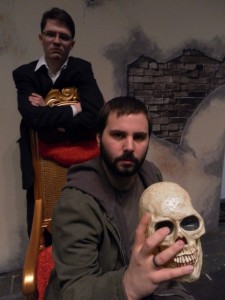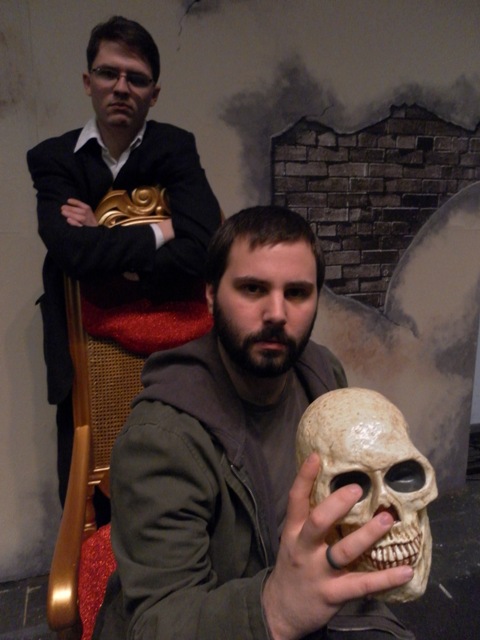
Seated, front: Conor Mulligan (Hamlet) Standing, back: Marshall B Garrett (Horatio) in Milburn Stone Theatre's production of HAMLET.
STAGE provided me with a wonderful opportunity to experience The Underground’s production of THE TRAGEDY OF HAMLET at the Milburn Stone Theater in North East, MD.That’s not to say that each element about this creative and intriguing version of this masterpiece worked as well as the other but overall one left the theater realizing that they had definitely seen a “different” version of HAMLET.
Lee Lewis’s set construction strongly supported his intent to give the audience something they would remember. It was a three-tiered construction employing a raked stage area, strategically placed/used curtained areas, and multiple staircases with perhaps one staircase too many. This playing area was generally used well by this ensemble. One problem was with the snow effect being so loud that it drowned out the key exposition of the first scene. The inventive and well-assembled video projection across the back wall kept the audience squarely in the 21st century as the opening videos provided some well-known clips of political assassinations combined with Presidential candidate Ron Paul’s concern about whether America was now “accepting” the elimination of habeus corpus, hidden prisons/prisoners, torture and government sanctioned death.
Seating the audience ON the stage facing what actors know as stage right provided a sometimes unsettling (but exciting) sense of intimacy as the actors used the aisle for entrances/exits often beginning the action during their approaches. Keeping the ambience dark and uncomfortable worked overall, but there were times when actors did not (or could not) find their lighting.
Setting this version at the White House in the West Wing was unique and uncomfortably close to reality. Current public sensibilities around “behind the scenes” decision making and un-American activities made Hamlet seem more relevant than ever. It does reinforce the adage of history repeating itself. Troubled marriages, emotionally distraught children, leaders struggling with inside and outside pressures all existed during Shakespeare’s time as well for the recent political residents of DC. Language changes including LA, New Haven and Washington were made in this oft-reinterpreted text to make it easier for the audience to follow the action.
The most enjoyable element for this reviewer was the decision by Lewis to allow Horatio (most ably played by Marshall B. Garrett), exhorted early in the play to keep his eyes/ears open, to actually APPEAR in other scenes. The tiers were perfect to allow Horatio to be seen eavesdropping while not being disruptive to the scene onstage. This reviewer is still uncertain about having Horatio appear with Hamlet during the famous “To be or not to be” monologue but the other times he appeared he fit.
The intentional gender-switching of characters generally worked without problem. The language was originally written during an age when young boys/men played the women’s roles and so scenes containing impassioned cries did not seem out of place… in fact, they fit a little better. The one place where this concept did not work was among Hamlet (played robustly and emotionally by Conor Mulligan), Ophelia (played by Sara Truitt as a confused valley girl) and Rosencrantz (a delightful addition portrayed by Tess Pohlhaus). Lewis directed the relationship of Hamlet with Rosencrantz to the detriment of this pair of usual lovers. Theatrical historians have long argued whether Ophelia “really” loved Hamlet or vice versa. Lewis took this question off the table for this production as the blocking and staging of Hamlet/Ophelia scenes looked and sounded contrived. Once Rosencrantz appeared, it was very clear that THEY had the real and romantic relationship. From that point on the rationale for Hamlet caring for Ophelia seemed awkward and unnatural.
While there is not a lot of Shakespearean history in their various resumes, this cast worked well together to create appropriate situations with emotional levels while wrapping their tongues around difficult language. Congrats to Polonius (played with panache by Vaughan Ellerton) for providing a crystal clear recitation of the items shared with Laertes upon his imminent departure. Kudos to Russell Matthews who excelled in providing the audience with the three very different characters of the ghost of Hamlet Sr., the Player King and the First Gravedigger. Gertrude (played maternally and regally by Melanie Bishop) was easy to look at and easy to hear. Clarity and diction were clouded by trying to use modern language cadence doing iambic pentameter but worked as long as the characters were not emotionally invested. Once their emotions kicked in, diction left the stage and much of the language was lost although sufficiently represented by the action that took its place.
A grand and very interesting variation on a classic theme was this production. This reviewer loves to see productions where risks are taken and creativity rules. That was definitely the case for this Hamlet. Sorry to all others who didn’t find the time to spend an evening with Hamlet et. al. at the White House!
HAMLET
by William Shakespeare
Directed by Lee Lewis
January 27 – 30, 2011
Milburn Stone Theatre
One Seahawk Drive
North East, MD
(410) 287-1023
www.milburnstone.org


